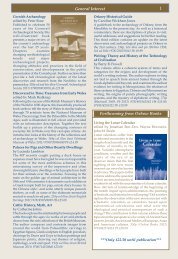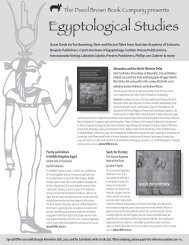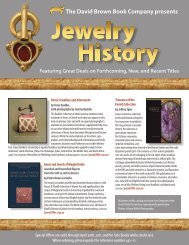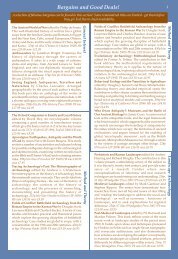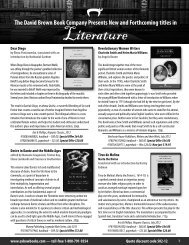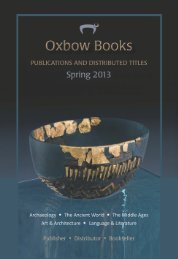New Distributed Titles Fall 2009 - Oxbow Books
New Distributed Titles Fall 2009 - Oxbow Books
New Distributed Titles Fall 2009 - Oxbow Books
You also want an ePaper? Increase the reach of your titles
YUMPU automatically turns print PDFs into web optimized ePapers that Google loves.
Demotic Papyri from the Memphite Necropolis<br />
In the Collections of the National Museum of Antiquities<br />
in Leiden, the British Museum and the Hermitage Museum<br />
by Cary J Martin<br />
The Demotic texts published in this volume come from the archives of the funerary<br />
workers of the Memphite necropolis. The papyri date to the Ptolemaic<br />
Period and were discovered early in the 19th century. The book is in two<br />
sections. The first part provides an introduction to the archives and to the<br />
funerary workers and their families. The topography of the necropolis is discussed<br />
and the different types of tomb structures and funerary income are<br />
examined. The second part contains full editions of and commentaries on<br />
nine of the papyri, most of which are either unpublished or only available in summary and now-out-of-date editions.<br />
Seven of the texts are kept in the National Museum of Antiquities in Leiden; one is in the British Museum and another<br />
is in the Hermitage. Full photographs of each papyrus are provided; detailed indexes complete the publication.<br />
270p, illus, paperback, 9782503530574, $115.00(s), Brepols Publishers, November <strong>2009</strong>,<br />
Papers on Archaeology from The Leiden Museum of Antiquities 5.<br />
Coptic Paradigms<br />
A Summary of Sahidic Coptic Morphology<br />
by Gregory E Sterling<br />
Facility in reading an ancient language requires<br />
several competencies: control of the morphology, a<br />
working vocabulary of common words and phrases,<br />
and a grasp of syntax. This pedagogical aide addresses<br />
the first of these by collecting the basic forms<br />
and patterns of Sahidic Coptic and presenting them<br />
in a convenient format. It is not a full grammar, but a<br />
supplement to a grammar. The work provides beginning<br />
students with an overview of the morphology of Sahidic Coptic so that they can see<br />
the whole of a part of speech or pattern as they learn discrete parts. It offers a concise<br />
review to those who once learned Coptic but have not been able to maintain it. While<br />
the work is not exhaustive, it is complete enough that it can serve as a useful reference<br />
for those who teach Coptic.<br />
95p, paperback, 9789042918726, $18.00, Peeters Publishers, December 2008.<br />
Palästinisches Hieratisch<br />
Die Zahl- und Sonderzeichen in der althebräischen Schrift<br />
by Stefan Wimmer<br />
This volume focuses on Egyptian hieratic signs found in Hebrew inscriptions of Iron Age II<br />
date. It contains a catalog of over 200 mostly numerical inscriptions from ostraca, vessels,<br />
weights and other analyzed artifacts. German text.<br />
306p, illus, hardback, 9783447058629, $111.00(s), Harrassowitz Verlag, December 2008,<br />
Ägypten und Altes Testament 75.<br />
ancient egypt<br />
A Coptic Learning Grammar (Sahidic)<br />
by Johanna Brankaer<br />
This textbook is written for students who are new to Coptic and for those who<br />
already have a first understanding of the language. The book consists of two<br />
main parts, elements and constructions, followed by application exercises<br />
and a selection of texts. The student gradually learns the Coptic constructions<br />
with reference to the elements that are relevant for each construction.<br />
A Coptic Learning Grammar is not only a teaching method for Sahidic, the<br />
‘classical’ Coptic dialect, but can also be used as a reference tool for students<br />
who are already familiar with the language.<br />
200p, paperback, 9783447058940, $45.00(s), Harrassowitz Verlag,<br />
October <strong>2009</strong>, Subsidia et Instrumenta Linguarum Orientis 1.<br />
Bulletin of the Egyptological Seminar (BES)<br />
Vol. 18 – <strong>2009</strong><br />
edited by Dag Bergman, Diane Bergman, Dieter Arnold<br />
and John Gee<br />
Most of this issue of BES is devoted to “Abbreviations in Egyptology,” a comprehensive<br />
research tool that provides scholars with more than 5200 abbreviations<br />
used in Egyptological and Biblical literature. It is of particular use<br />
to those without ready access to the Lexikon der Ägyptologie. Also included<br />
are articles by Dieter Arnold discussing an exciting new discovery about the<br />
construction of Senwosret III’s pyramid at Dahshur and John Gee about the<br />
use of the adverbial component in Egyptian sentences.<br />
100p, 11 illus, paperback, 9780981612010, $40.00,<br />
Egyptological Seminar of <strong>New</strong> York, June <strong>2009</strong>.<br />
www.dbbconline.com 21




